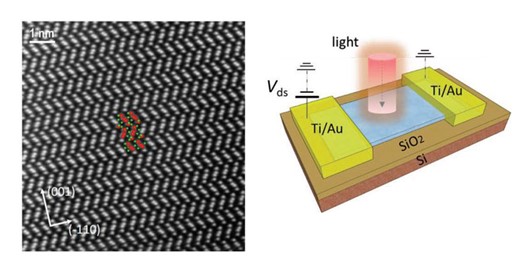Defects in layered materials enable ‘green’ high-performance infrared photodetectors
Tailoring material defects, Graphene Flagship researchers at ICFO created highly sensitive and CMOS-compatible broadband photodetectors.
Consumer electronics, including light emitting diodes and photodetectors, require infrared optoelectronics. To date, however, infrared optoelectronics are served by costly, non-CMOS compatible semiconductors. The use of materials that comply the EU Restriction of Hazardous Substances (RoHS) regulations is a prerequisite for consumer electronics. Therefore there is a strong need for the development of high-performance devices based on environmentally friendly elements.
To address this challenge, Graphene Flagship researchers at ICFO, in collaboration with the University of Zaragoza, Spain, have discovered that by controlling defects in layered materials, one can extend the spectral reach beyond their bandgap, for the infrared part of spectrum. They developed an infrared detector using bismuth sulfide (Bi2S3), with fast and high photo-response in the short-wave infrared thanks to the formation of defects.
The researchers, led by Gerasimos Konstantatos, fabricated a photoconductive detector, depositing bismuth sulfide flakes onto Si/SiO2. They observed that the flakes possessed sulphur vacancies or defects, which created extended in-gap states, increasing absorption of light below the bandgap of Bi2S3. This led to a high gain, low noise and, subsequently, a high sensitivity photodetector.
To understand the mechanism, they built a second photodetector and synthesized the Bi2S3 crystal, by performing a sulfurization process (changing the concentration of Bi and S) subsequently refilling the sulphur vacancies. The photodetector had a much faster response time but was limited to the spectral range in the near infrared. Thus, to improve the response time without sacrificing its spectral coverage, they carried out a mild chemical treatment on the sulphur-deficient-based detector, through a surface passivation process. The time response reached 10ms for the infrared and visible light range, 50 times faster than the original sulphur deficient-based detector.
Gerasimos Konstantatos comments that "to address the challenge of having highly performing infrared optoelectronic materials that are RoHS compliant, we found refuge in layered quasi-2D materials with a more complex crystal structure than that of transition metal dichalcogenides, traditionally explored until now. In doing so, we engineered crystal defects in a way that extends the spectral coverage of Bi2S3 beyond its bandgap and into the infrared, giving rise to materials with extraordinary properties."
The results of this study provide new insights into the role atomic vacancies play in the electronic structure and how sub-bandgap photo response effects can enable ultrasensitive, fast, and broadband photodetectors.

Daniel Neumaier, Graphene Flagship Division Leader for Electronics and Photonics Integration, believes that "this work represents an important step towards the exploitation of IR photodetectors and imaging systems in consumer electronics, enabled by an in principle silicon CMOS compatible fabrication process. The layered material Bi2S3 plays and important role in these IR detectors, demonstrating the potential of layered materials in extending the functionality of traditional silicon CMOS technology."
Andrea C. Ferrari, Science and Technology Officer of the Graphene Flagship and Chair of its Management Panel added "photodetectors in the infrared range are crucial for many applications. This work shows how layered materials can be engineered to widen their performance, while being compatible with a semiconductor fab process. This yet again shows that photonics and optoelectronics are amongst the most promising areas for application of these novel materials."
Reference:



